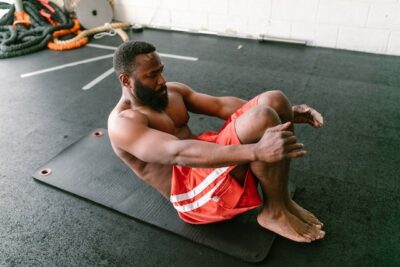In the pursuit of a healthier and more robust lifestyle, the foundation lies in a well-structured workout routine. Whether you’re a fitness enthusiast or just beginning your fitness journey, understanding the principles of an effective workout regimen is essential. This article provides a detailed and informative guide to crafting a workout routine catering to individual goals, preferences, and fitness levels.
The Fundamentals of an Effective Workout Routine:
An effective workout routine is built upon fundamental principles that cater to individual fitness goals and overall well-being.
Whether you’re a seasoned fitness enthusiast or a beginner taking the first steps toward a healthier lifestyle, understanding these fundamentals is essential for creating a workout routine that yields sustainable results. Here are the key fundamentals of an effective workout routine:
Goal Setting:
The foundation of any successful workout routine begins with clearly defined plans. Whether you aim to lose weight, build muscle, increase endurance, or improve overall health, setting specific, measurable, achievable, relevant, and time-bound (SMART) goals provides a roadmap for your fitness journey.
Balanced Exercise Selection:
An effective workout routine incorporates a balanced mix of exercises. This includes cardiovascular exercises (such as running, cycling, or swimming) for heart health and calorie burn, strength training to build muscle and increase metabolism, and flexibility exercises to enhance mobility and prevent injuries.
Frequency and Consistency:
Consistency is the cornerstone of fitness success. Establishing a regular workout schedule and sticking to it is crucial for seeing long-term results. The frequency of workouts depends on individual goals. Still, a general guideline is at least 150 minutes of moderate-intensity aerobic exercise per week, along with strength training exercises at least twice a week.
Intensity and Progression:
The power of your workouts should be appropriate for your fitness level and goals. Gradually increasing the power over time through a concept known as progressive overload is critical to ongoing improvement. This can involve lifting heavier weights, increasing the duration or intensity of cardio workouts, or incorporating more challenging exercises.
Martyn Ford Workout Principles:
Drawing inspiration from successful fitness figures like Martyn Ford can offer valuable insights into effective workout principles. Ford’s commitment to a balanced and intense workout routine is evident in his approach to fitness.
Rest and Recovery:
Adequate rest is an often underestimated aspect of an effective workout routine. Muscles need time to recover and repair to grow stronger. Incorporating rest days into your way and prioritizing quality sleep are essential components of a well-rounded fitness plan.
Individualization:
Recognizing that everyone is unique, an effective workout routine is personalized to individual preferences, fitness levels, and lifestyles. Tailoring your routine to activities you enjoy increases the likelihood of adherence and long-term success.
Nutrition and Hydration:
A balanced and nutritious diet complements a well-rounded workout routine. Fueling your body with the right nutrients, staying hydrated, and considering pre-and post-workout nutrition are integral to achieving optimal performance and recovery.
Designing Your Workout Routine:
Designing a personalized workout routine is a dynamic and exciting process that involves tailoring your fitness plan to align with your specific goals, preferences, and fitness level. Whether you’re aiming to build muscle, improve cardiovascular health, or enhance overall well-being, the following steps will guide you in crafting a workout routine that suits your needs:
Assess Your Fitness Level:
Begin by assessing your current fitness level. This includes evaluating your endurance, strength, flexibility, and any existing health considerations. Understanding where you are starting from provides a baseline for setting realistic and achievable goals.
Define Your Fitness Goals:
Clearly define your fitness goals. Whether you’re aiming for weight loss, muscle gain, improved athletic performance, or enhanced flexibility, having specific and measurable goals will shape the structure of your workout routine.
Choose Your Activities:
Select activities that you enjoy and that align with your goals. If you love running, consider incorporating cardiovascular exercises such as jogging or sprint intervals. If you prefer strength training, focus on weightlifting or bodyweight exercises. Including activities you enjoy increases the likelihood of sticking to your routine.
Cardiovascular Exercise:
Depending on your goals, incorporate cardiovascular exercises into your routine. Aim for at least 150 minutes of moderate-intensity aerobic exercise per week. This can include activities like running, cycling, swimming, or group fitness classes.
Strength Training:
Design a strength training component that targets major muscle groups. Include compound exercises like squats, deadlifts, bench presses, and isolation exercises to address specific muscles. Gradually increase the intensity and resistance to promote muscle growth and strength.
Flexibility and Mobility:
Integrate flexibility and mobility exercises to improve range of motion and prevent injuries. Activities like yoga or dynamic stretching can enhance flexibility, reduce muscle stiffness, and contribute to overall joint health.
Create a Schedule:
Establish a realistic and sustainable workout schedule. Consider your daily commitments, work hours, and personal preferences. Consistency is key, so choose a schedule you can realistically adhere to.
Include Rest Days:
Rest and recovery are integral to any effective workout routine. Schedule rest days to allow your muscles to recover and reduce the risk of overtraining. Listen to your body and adjust your way as needed.
Track Your Progress:
Record your workouts to track your progress. This can include the exercises performed, weights lifted, duration of cardio sessions, and any notable achievements. Regularly reassess your goals and adjust your routine accordingly.
Stay Hydrated and Nourished:
Proper nutrition and hydration are essential for supporting your workouts and aiding in recovery. Ensure you are adequately fueled before exercising, stay hydrated throughout your workouts, and consider post-workout nutrition to replenish energy stores.
Seek Professional Guidance:
If you’re new to exercise or have specific goals that require expertise, consider consulting with a fitness professional. They can help you design a personalized workout routine, provide guidance on proper form, and offer motivation and support.
Customizing Your Workout Routine:
Customizing your workout routine is crucial in ensuring that your fitness plan aligns with your individual goals, preferences, and lifestyle. While general principles form the foundation of effective workouts, tailoring your routine to suit your specific needs enhances adherence and increases the likelihood of long-term success. Here’s a detailed look at the critical aspects of customizing your workout routine:
Individual Preferences:
The first step in customization is to incorporate activities you genuinely enjoy. Whether cycling, swimming, dancing, or practicing martial arts, choosing exercises that align with your interests makes the workout experience more enjoyable and sustainable.
Variety and Diversity:
To prevent boredom and target different muscle groups, introduce variety into your routine. This could involve trying different forms of exercise, incorporating new workout classes, or exploring outdoor activities. The more diverse your routine, the more likely you are to stay engaged.
Adaptation to Fitness Level:
Customizing your workout routine requires adapting exercises to your current fitness level. If you’re a beginner, start with foundational movements and gradually progress to more advanced exercises as your strength and endurance improve. Conversely, challenge yourself with higher-intensity workouts if you’re more advanced.
Time Management:
Consider your schedule and allocate time for workouts that align with your daily routine. Whether it’s early morning, during lunch, or in the evening, choosing a time that suits you increases the likelihood of consistency.
Social Component:
For some individuals, incorporating a social aspect into their workout routine enhances motivation. This could involve joining group fitness classes, participating in team sports, or working out with a friend or family member. The social element adds a layer of accountability and enjoyment.
Home vs. Gym Workouts:
Consider your environment preferences. Some people thrive in a gym setting with access to equipment, while others prefer home workouts. Customizing your routine to fit your preferred setting ensures a seamless integration into your lifestyle.
Fitness Apps and Technology:
Leverage technology to customize your workout experience. Fitness apps can provide personalized workout plans, track your progress, and offer guidance on form. Wearable devices can monitor your activity levels and provide real-time feedback.
Listen to Your Body:
Customization also involves tuning in to your body’s signals. If you’re fatigued or experiencing soreness, adjust your intensity or incorporate active recovery days. Honoring your body’s needs reduces the risk of overtraining and injuries.
Flexibility in Planning:
Life can be unpredictable, and customizing your workout routine means flexible planning. If unexpected events disrupt your schedule, have alternative workout options or shorter practices that can be easily integrated.
Regular Assessments:
Periodically assess your progress and reassess your goals. If you’ve achieved certain milestones, consider tweaking your routine to introduce new challenges and keep your workouts stimulating.
Final Thoughts:
In crafting a workout routine, find a balance that aligns with your goals, preferences, and lifestyle. The principles of goal setting, balanced exercise selection, consistency, and inspiration from notable figures like Martyn Ford can guide you in designing a regimen that promotes optimal fitness and well-being. Remember, the journey to a healthier lifestyle is personal, and a well-thought-out workout routine is your roadmap to success.









